Table of Contents
Are you ready to initiate on a culinary adventure that will transport your taste buds to the bustling streets of Bangkok? With its bold and aromatic flavors, Thai cuisine has captivated palates around the world. And now, you can bring the essence of Thailand into your kitchen with ease.
In this comprehensive guide, you’ll learn the fundamentals of Thai cooking, discover imperative ingredients, and master techniques for crafting authentic dishes, pastes, and sauces that will leave your family and friends craving for more.
Key Takeaways:
- Fundamentals of Thai Cooking: Mastering the basics of Thai cooking is crucial to bringing authentic flavors to your kitchen. This includes understanding the role of key ingredients, cooking techniques, and methods for creating flavorful dishes.
- Essential Ingredients and Methods: Learn about the must-have ingredients and cooking methods used in Thai cuisine, such as creating flavorful pastes and sauces, to elevate your dishes to the next level.
- Authentic and Easy-to-Make Dishes: Discover well-known Thai dishes that are simple to make at home, from savory meals to sweet desserts, and impress your family and friends with your new culinary skills.
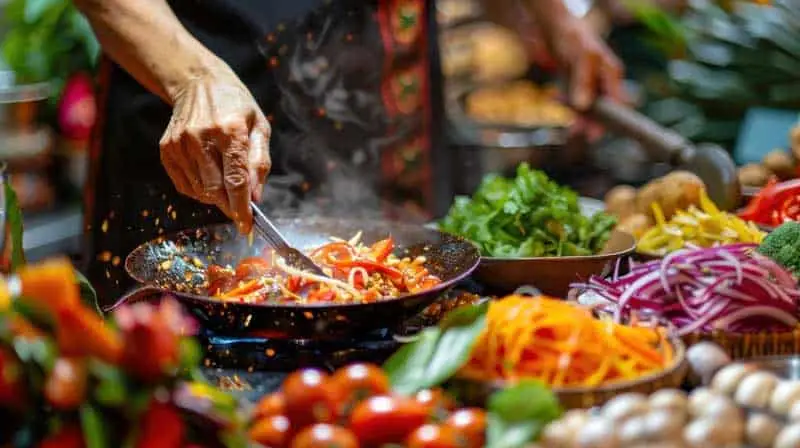
Knowing the Fundamentals of Thai Cooking
The foundation of Thai cooking lies in its emphasis on balance, freshness, and quality. Mastering these fundamental principles will elevate your dishes and bring the authentic flavors of Thailand to your kitchen.
Understanding the Balance of Flavors
Achieving harmony among sweet, sour, salty, and umami flavors is crucial in Thai cuisine. You’ll need to balance these elements to create dishes that are both refreshing and savory.
Familiarizing Yourself with Common Thai Ingredients
Thai cuisine relies heavily on aromatic ingredients like lemongrass, galangal, and kaffir lime leaves. These flavors will become the backbone of your Thai dishes, so it’s necessary to get familiar with them.
Thai ingredients like fish sauce, lime juice, and palm sugar may be unfamiliar to you, but they’re necessary in creating authentic Thai flavors. Experiment with these ingredients to understand their unique properties and how they interact with each other.
The Importance of Freshness and Quality in Thai Cooking
An abundance of fresh herbs and vegetables is vital in Thai cooking. Using wilted or low-quality ingredients will result in dishes that lack depth and vibrancy.
It’s crucial to choose fresh and aromatic ingredients, as they will elevate the flavors of your dishes. Avoid using old or stale spices, as they can compromise the overall taste of your creations. By prioritizing freshness and quality, you’ll be able to create dishes that are truly representative of Thai cuisine.
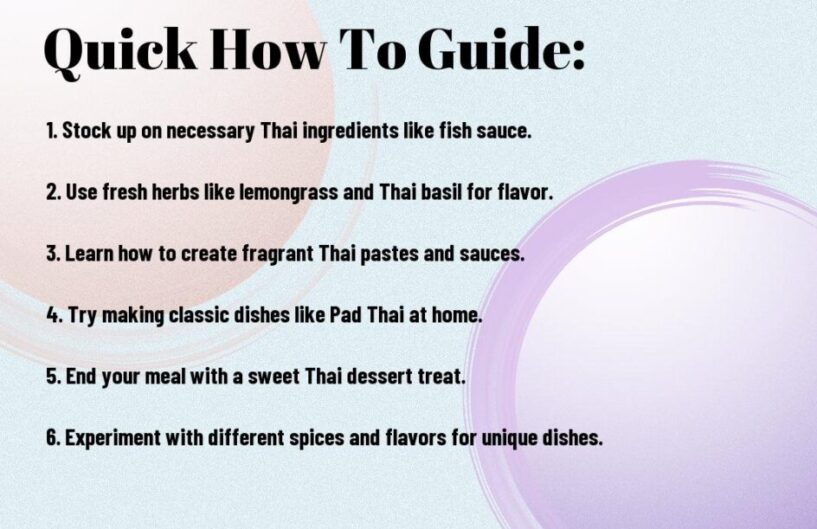
Essential Components for Thai Cuisine
Clearly, the foundation of Thai cuisine lies in its vital components, which set it apart from other culinary traditions. To create authentic Thai dishes, you’ll need to familiarize yourself with these fundamental elements.
If you’re new to Thai cooking, a great resource to get you started is A Taste of Thailand: Thai Cooking Made Easy with Authentic Recipes.
How to Choose the Right Type of Rice
You might be surprised to learn that the type of rice you use can greatly impact the flavor and texture of your Thai dishes. Opt for high-quality jasmine rice, which is specifically designed to pair well with the bold flavors of Thai cuisine.
The Role of Fresh Herbs in Thai Cooking
Right from the start, fresh herbs play a crucial role in Thai cooking, adding depth and freshness to your dishes. From basil to cilantro, these fragrant leaves will elevate your culinary creations.
Thai cuisine relies heavily on fresh herbs to create bold and aromatic flavors. By incorporating herbs like lemongrass, galangal, and kaffir lime leaves into your recipes, you’ll be able to recreate the authentic flavors of Thailand.
Tips for Selecting the Freshest Vegetables and Fruits
The key to creating vibrant and flavorful Thai dishes lies in selecting the freshest vegetables and fruits. When shopping, look for produce that is firm, vibrant in color, and free of bruises. After choosing the best ingredients, you’ll be able to craft dishes that burst with flavor and color.
A trip to the local market or grocery store can be overwhelming, especially when it comes to selecting the freshest produce. To ensure you’re getting the best, look for
- crisp leafy greens
- plump and vibrant fruits
- firm and heavy vegetables
. After selecting the freshest ingredients, you’ll be able to craft dishes that are both nourishing and delicious.

The Harmony of Tastes in Thai Food
Not every cuisine can boast the perfect balance of flavors like Thai food does. The secret to this harmony lies in the careful combination of five fundamental tastes: sweet, sour, salty, bitter, and umami.
Understanding the Five Fundamental Tastes in Thai Cuisine
Thai cuisine is built around the concept of balancing these five tastes to create a harmonious flavor experience. Each taste plays a crucial role in enhancing the overall flavor profile of a dish.
How to Balance Sweet, Sour, Salty, Bitter, and Umami Flavors
While it may seem like a daunting task, balancing these flavors is easier than you think. Start by identifying the dominant taste in your dish and adjust the other flavors accordingly.
Understanding the role of each taste is key to achieving harmony. Sweetness comes from sugar, palm sugar, or fruits, while sourness is derived from citrus, vinegar, or tomatoes. Saltiness is added through fish sauce, soy sauce, or salt, and bitterness comes from vegetables like bitter melon or herbs like Thai basil. Umami flavor is often achieved through the use of fish sauce, shrimp paste, or mushrooms.
Factors Affecting the Harmony of Tastes in Thai Dishes
With so many factors at play, it’s important to consider the following elements when balancing the flavors in your Thai dishes:
- Regional ingredients: Different regions in Thailand use unique ingredients that affect the flavor profile.
- Personal taste preferences: Adjust the flavors according to your personal taste buds.
- Ingredient quality: Fresh and high-quality ingredients can greatly impact the flavor balance.
Recognizing these factors will help you create authentic and delicious Thai dishes that showcase the perfect harmony of tastes.
The key to mastering the harmony of tastes in Thai food is to experiment and adjust the flavors according to your personal preferences. Don’t be afraid to try new ingredients and flavor combinations, and remember that practice makes perfect. With time and patience, you’ll be able to create mouth-watering Thai dishes that will impress even the most discerning palates.
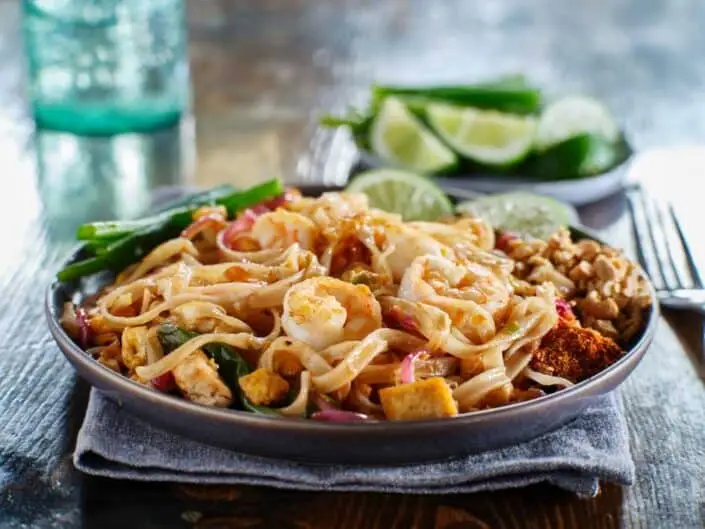
Techniques for Thai Cooking
For any aspiring Thai chef, mastering the fundamental techniques is crucial to creating authentic and mouth-watering dishes. In this section, we’ll explore the crucial methods to bring the zesty flavors of Thailand to your kitchen.
How to Prepare Perfectly Cooked Jasmine Rice
If you’re looking to cook Thai-style jasmine rice, remember to rinse it thoroughly before cooking to remove excess starch. Then, use a 1:1.25 water-to-rice ratio and bring to a boil. Reduce heat, cover, and simmer for 15-20 minutes or until the water is absorbed and the rice is fluffy.
Mastering the Art of Stir-Frying in Thai Cooking
Cooking stir-fries quickly over high heat is crucial in Thai cuisine. This technique helps preserve the nutrients and texture of the ingredients while infusing them with bold flavors.
With a hot wok or large skillet, you can achieve the perfect stir-fry. Add aromatics like garlic and chilies, followed by your protein and vegetables, and finish with a flavorful sauce. Remember to stir constantly and cook for 2-3 minutes or until the ingredients are cooked through.
Tips for Grilling and Roasting in Thai Cuisine
Now that you’ve mastered stir-frying, it’s time to explore the art of grilling and roasting in Thai cooking. Here are some crucial tips to get you started:
- Marinate your meat or seafood in a mixture of fish sauce, lime juice, and herbs like lemongrass and galangal.
- Preheat your grill or oven to high heat to achieve a nice char.
- Baste your dish with a flavorful sauce during the last few minutes of cooking.
Recognizing the importance of these techniques will elevate your Thai dishes to the next level.
This attention to detail will result in tender, juicy meat and seafood, infused with the bold flavors of Thailand. By incorporating these grilling and roasting techniques into your repertoire, you’ll be able to create mouth-watering dishes like Satay and Larb Moo.
The Significance of a Pestle and Mortar
Despite the modern convenience of electric blenders and food processors, a traditional pestle and mortar remains an crucial tool in Thai cooking. This ancient utensil is still widely used in Thai kitchens today, and for good reason. The pestle and mortar allows for a level of control and precision that electric appliances simply can’t match, making it an indispensable tool for releasing the full flavors and aromas of your ingredients.
How to Choose the Right Pestle and Mortar for Thai Cooking
Little things can make a big difference when it comes to choosing the right pestle and mortar for Thai cooking. Look for a mortar made from a durable material like granite or clay, and a pestle that fits comfortably in your hand. A larger mortar may seem convenient, but it can be cumbersome to handle and may not allow for the same level of precision as a smaller one.
Techniques for Grinding and Mixing Ingredients
For the best results, start by grinding your ingredients in a circular motion, gradually increasing the pressure as needed. Be patient and take your time, as this process can be meditative and rewarding.
Ingredients like lemongrass, galangal, and chilies require a bit more elbow grease to break down, but the end result is well worth the effort. As you grind and mix your ingredients, you’ll begin to notice the aromas and flavors releasing, and your senses will come alive with the possibilities.
The Importance of Freshly Ground Spices in Thai Cuisine
Spices like cumin, coriander, and cardamom are staples in Thai cooking, and freshly grinding them in a pestle and mortar makes all the difference. The volatile oils and flavor compounds in these spices are released when they’re freshly ground, adding depth and complexity to your dishes.
Significance of freshly ground spices can’t be overstated. It’s the difference between a dull, uninspired dish and one that’s vibrant and alive with flavor. By taking the time to grind your spices fresh, you’ll be rewarded with a culinary experience that’s truly authentic and delicious.
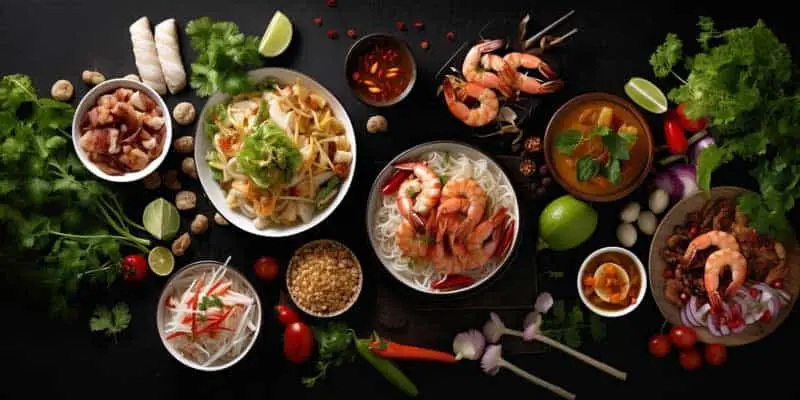
Thai Pastes & Sauces
After exploring the fundamental spices and ingredients of Thai cuisine, it’s time to examine the heart of Thai cooking: pastes and sauces. These flavorful condiments are the backbone of Thai dishes, adding depth, complexity, and aroma to your creations.
How to Make Your Own Thai Red Curry Paste
Even if you’re new to Thai cooking, making your own Thai red curry paste is easier than you think. Simply combine coriander seeds, cumin seeds, cinnamon sticks, cardamom pods, and dried red chilies in a blender or food processor, then add in garlic, shallots, lemongrass, and galangal for added flavor.
The Role of Fish Sauce in Thai Sauces and Marinades
Sauces and marinades are an necessary component of Thai cooking, and fish sauce plays a starring role. This salty, umami-rich condiment adds depth and complexity to your dishes, balancing out the sweetness and spiciness of other ingredients.
Sauces like nam pla wan (sweet fish sauce) and nam jim jaew (spicy dipping sauce) rely heavily on fish sauce, which provides a savory, slightly sweet flavor. When used in marinades, fish sauce helps to tenderize meat and seafood, while also infusing them with flavor.
Tips for Preparing Authentic Thai Peanut Sauce
Fish out your blender or food processor, because making authentic Thai peanut sauce is a breeze. Combine peanuts, coconut milk, fish sauce, lime juice, brown sugar, and chili flakes for a creamy, spicy sauce. This sauce is perfect for noodle dishes, satay, and grilled meats.
- Use high-quality peanuts for the best flavor.
- Adjust the level of spiciness to your liking with chili flakes.
- For a creamier sauce, add more coconut milk.
This sauce is incredibly versatile, so don’t be afraid to experiment and adjust the flavors to your taste.
Thai peanut sauce is a staple condiment in Thai cuisine, and with these simple tips, you can create an authentic, delicious sauce in no time. Whether you’re serving it with noodles, satay, or grilled meats, this sauce is sure to impress.
Fish Sauce’s Place in Thai Cuisine
To truly capture the essence of Thai cooking, you need to understand the significance of fish sauce in Thai cuisine. This condiment is a staple in every Thai kitchen, and its umami flavor adds depth and complexity to a wide range of dishes.
Understanding the Flavor Profile of Fish Sauce
Fishy undertones, salty notes, and a hint of sweetness define the flavor profile of fish sauce. It’s a savory condiment that enhances the overall flavor of a dish without overpowering it.
How to Use Fish Sauce in Thai Recipes
Little goes a long way when it comes to using fish sauce in Thai recipes. Start with a small amount and adjust to taste, as the flavor can quickly become overwhelming.
Cuisine experts recommend using fish sauce as a seasoning towards the end of cooking, as high heat can cause the flavor to dissipate. Add it to marinades, sauces, and stir-fries to experience the full range of its flavor-enhancing capabilities.
Factors to Consider When Choosing a Fish Sauce
Sauces vary greatly in terms of quality and flavor, so it’s crucial to choose a good fish sauce for your Thai cooking adventures. Look for a fish sauce with the following characteristics:
- High-quality fish: Opt for a fish sauce made from small, oily fish like anchovies or sardines.
- Low sodium content: Choose a fish sauce with lower sodium levels to avoid overpowering your dishes.
- No added preservatives: Select a fish sauce with natural preservatives like salt or sugar.
This ensures that you’re getting a fish sauce that will elevate your Thai dishes without compromising on flavor or nutrition.
Fish sauce is a crucial element in Thai cooking, and choosing the right one can make all the difference in the flavor and authenticity of your dishes. By understanding its flavor profile, using it correctly, and selecting a high-quality fish sauce, you’ll be well on your way to creating delicious and authentic Thai cuisine.
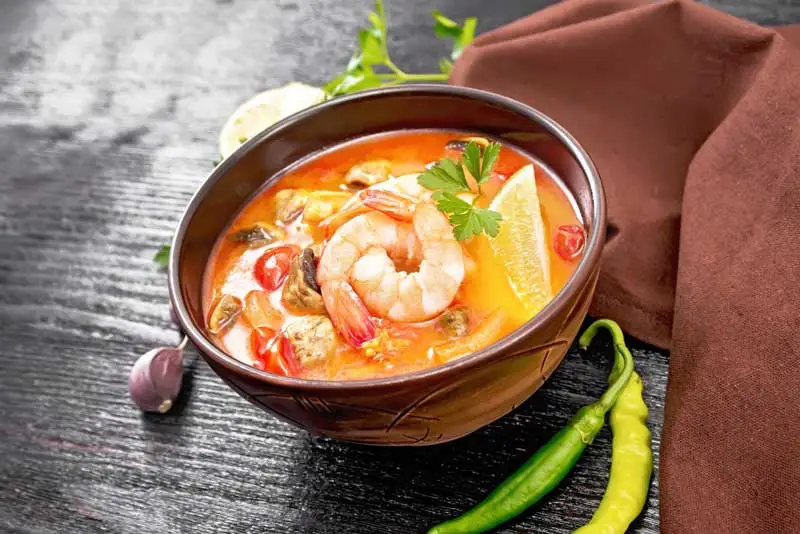
Common Thai Recipes You Can Prepare at Home
Many people think that cooking Thai food is complicated, but with a few simple techniques and ingredients, you can create delicious and authentic Thai dishes in the comfort of your own kitchen.
How to Make Delicious Pad Thai
Any lover of Thai food knows that Pad Thai is a staple dish that is both easy to make and packed with flavor. To create this classic dish, simply stir-fry rice noodles with shrimp, tofu, and bean sprouts, and season with tamarind paste, fish sauce, and palm sugar.
Tips for Preparing Authentic Tom Yum Soup
If you’re looking to add a burst of citrusy flavor to your meal, Tom Yum Soup is the perfect choice. To make it, combine coconut milk, lemongrass, lime leaves, and your choice of protein (such as shrimp or chicken) in a pot, and season with fish sauce, lime juice, and chili flakes. Knowing these simple steps will have you enjoying a steaming bowl of Tom Yum in no time.
Here are some key ingredients to keep in mind when making Tom Yum Soup:
- Lemongrass: adds a bright, citrusy flavor
- Kaffir lime leaves: provides a subtle, herbal note
- Fish sauce: adds depth and umami flavor
- Chili flakes: adds heat and spice
Common mistakes to avoid when making Tom Yum Soup include not using enough aromatics, such as lemongrass and lime leaves, and not balancing the flavors correctly. With a little practice, you’ll be a pro at making this iconic Thai soup!
Mastering the Art of Green Curry with Chicken and Vegetables
Soup up your meal with a creamy and flavorful Green Curry. To make it, simply sauté onions, garlic, and your choice of protein (such as chicken or shrimp) in a pan, then add in a mixture of coconut milk, green curry paste, and your choice of vegetables (such as bell peppers and bamboo shoots).
With a few simple tweaks, you can customize your Green Curry to your taste. Try adding in different vegetables, such as Thai eggplant or zucchini, or using different types of protein, such as tofu or pork. The key to making a great Green Curry is to balance the flavors correctly, so don’t be afraid to experiment and adjust the seasoning to your taste.
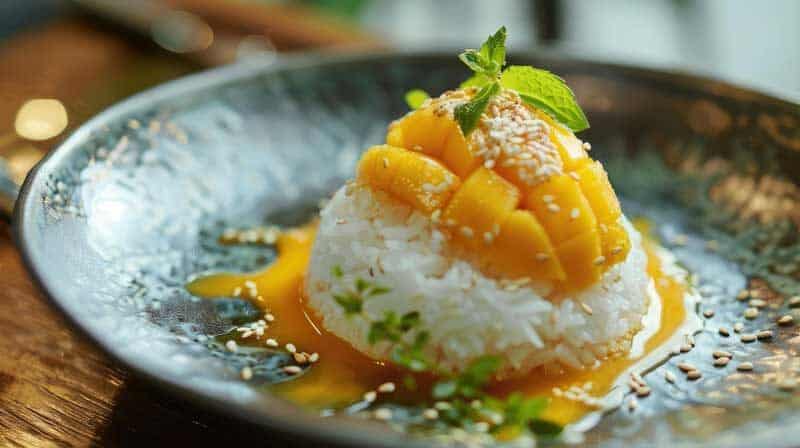
Thai Desserts
Unlike many Western desserts, Thai sweets often feature bold and refreshing flavors, making them a perfect way to conclude a meal. In Thai cuisine, desserts are not just a sweet treat, but an integral part of the dining experience.
One of the key ingredients in many Thai desserts is ginger, which adds a warm and spicy flavor. To learn more about the uses and benefits of ginger in Thai cooking, check out Thailand Ginger: Culinary Uses, Growing Tips & Global Impact.
How to Make Traditional Thai Mango Sticky Rice
On a warm day, there’s nothing quite like a sweet and creamy serving of mango sticky rice. To make this classic Thai dessert, start by cooking glutinous rice with coconut milk and a touch of salt. Then, slice fresh mango and serve it on top of the sticky rice, drizzling with a sweet coconut sauce.
Tips for Preparing Coconut Ice Cream with Thai Flair
With a few simple ingredients, you can create a creamy and refreshing coconut ice cream that’s infused with the flavors of Thailand. Here are some tips to get you started:
- Coconut milk is a must-have ingredient, providing a rich and creamy texture.
- Pandan leaves add a unique and aromatic flavor to the ice cream.
- Sweet and salty flavors balance out the richness of the coconut milk.
Thou shalt not forget to experiment with different flavors and toppings, such as toasted coconut flakes or crispy rice cereal, to create a truly unique dessert.
Preparing coconut ice cream with Thai flair requires a bit of patience and creativity. Start by combining coconut milk, sugar, and a pinch of salt in a blender. Then, add in a few drops of pandan extract or a handful of pandan leaves for added flavor. Pour the mixture into an ice cream maker and churn until smooth. Finally, transfer the ice cream to a freezer-safe container and freeze until set.
The Art of Creating Beautiful Thai Fruit Carvings
Tips for creating stunning fruit carvings include using a variety of colorful fruits, such as mangoes, kiwis, and strawberries, and experimenting with different cutting techniques and tools. With a little practice, you can create intricate designs and patterns that will elevate your desserts to a whole new level.
Creating beautiful Thai fruit carvings requires patience, skill, and attention to detail. Start by selecting a variety of fresh fruits and cutting them into thin slices or wedges. Then, use a sharp knife or carving tool to create intricate designs and patterns. Finally, arrange the carved fruits on a platter or individual serving dishes for a stunning presentation.
Final Words
As a reminder, the art of bringing the zesty flavors of Thailand to your kitchen lies in mastering the fundamentals, experimenting with key ingredients, and perfecting the craft of creating authentic Thai pastes and sauces. With the guidance provided in this culinary guide, you now have the tools to unlock the secrets of Thai cooking and delight your taste buds with the bold flavors and aromas of this beloved cuisine. Happy cooking, and enjoy the culinary journey to Thailand from the comfort of your own kitchen!
FAQ
Q: What are the imperative methods and products needed to bring the flavors of Thailand into my kitchen?
A: To bring the zesty flavors of Thailand into your kitchen, you’ll need to master the fundamentals of Thai cooking, including understanding key ingredients, cooking techniques, and learning how to create authentic Thai pastes and sauces. This guide will walk you through the imperative methods and products required to create delicious and authentic Thai dishes.
Q: What kind of key ingredients are used in Thai cooking, and where can I find them?
A: Thai cooking relies heavily on a variety of aromatic spices, herbs, and other ingredients such as lemongrass, galangal, fish sauce, and chili peppers. You can find these ingredients at most Asian markets or online. This guide will provide you with a comprehensive list of key ingredients and tips on where to find them, as well as substitutes and alternatives for harder-to-find items.
Q: Are Thai dishes difficult to make at home, and what are some simple and well-known dishes I can start with?
A: Not at all! While Thai cooking may seem intimidating, many popular dishes are surprisingly easy to make at home. This guide will introduce you to simple and well-known Thai dishes such as Pad Thai, Tom Yum Soup, and Green Curry, as well as provide step-by-step instructions and tips for creating these dishes in your own kitchen. With a little practice, you’ll be cooking like a Thai chef in no time!


